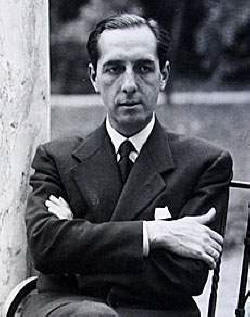

Queer Places:
Calle Real de Villafranca, 25, 41720 Los Palacios y Villafranca, Sevilla, Spain
Royal Alcázar of Seville, Patio de Banderas, s/n, 41004 Sevilla, Spain
 Joaquín Romero Murube (18 July 1904 – 15 November 1969) was an articleist and poet of the 27th generation. From 1934 until his death he was director-conservative of the Real Alcázar de Sevilla.
In the 1920s writers more openly homosexual were not able to deal with the
topic in their works. These include the conservative dramatist Jacinto Benavente, the chronicler of Madrid life
Pedro de Répide, the short
story writer Antonio de Hoyos
y Vinent, and the music critic and historian
Adolfo Salazar. Many
Spaniards escaped to Paris, among them
Gregorio Martinez Sierra and Marta
Martinez Sierra and the composer Manuel de Falla. Little magazines, such as
Grecia of Adriano del
Valle, Mediodia of
Joaquin Romero Murube, and
Renacimiento of Martinez
Sierra, remain incompletely studied. Even into the 1920's the situation for
homosexuals was oppressive, as can be seen from the reticence of the
Espasa-Calpe encyclopedia and the comments of Gregorio Maranon. It was
foreigners living in Spain, the Uruguayan
Alberto Nin Frías, the Chilean
Augusto
d'Halmar, and the Cuban Alfonso Hernández Catá, who published the first books on the topic.
Joaquín Romero Murube (18 July 1904 – 15 November 1969) was an articleist and poet of the 27th generation. From 1934 until his death he was director-conservative of the Real Alcázar de Sevilla.
In the 1920s writers more openly homosexual were not able to deal with the
topic in their works. These include the conservative dramatist Jacinto Benavente, the chronicler of Madrid life
Pedro de Répide, the short
story writer Antonio de Hoyos
y Vinent, and the music critic and historian
Adolfo Salazar. Many
Spaniards escaped to Paris, among them
Gregorio Martinez Sierra and Marta
Martinez Sierra and the composer Manuel de Falla. Little magazines, such as
Grecia of Adriano del
Valle, Mediodia of
Joaquin Romero Murube, and
Renacimiento of Martinez
Sierra, remain incompletely studied. Even into the 1920's the situation for
homosexuals was oppressive, as can be seen from the reticence of the
Espasa-Calpe encyclopedia and the comments of Gregorio Maranon. It was
foreigners living in Spain, the Uruguayan
Alberto Nin Frías, the Chilean
Augusto
d'Halmar, and the Cuban Alfonso Hernández Catá, who published the first books on the topic.
Joaquín Romero Murube was born in the current municipality of Los Palacios y Villafranca, in Calle Real de Villafranca (for the palatials "Calle Real"), in the current number 25, in 1904 and died in 1969. Official of the City of Seville and custodian of his Real Alcázar, from his position as editor-in-chief of the Sevillian poetic magazine Mediodía (1926-1929) he linked himself to the Poetic Vanguards related to the Generation of 27, of which he was not a part. He promoted the magazine El Ala del Sur by Pedro Garfias, one of the struts of Ultraism.
Among his poetic books are Prosarios (1924) and Passionate Shadow (1929), where the author alternates Creationism, Surrealism, Neopopularism and Classicism. Critics have also pointed to the influence of Ramón Gómez de la Serna, Valle-Inclán, José Bergamín and Pedro Salinas. Federico García Lorca's imronta is visible in his second poetic stage, composed of Seven Romances (1937), Song of the Andalusian Lover (1941) and Kasida del olvido (1945), continued and expanded in Tierra y canción (1948). His essays include God in the City, from 1934, then included in Seville on the Lips (1938); Discourse of lies (1943), Memorials and Ramblings (1951) and The Heavens We Lost (1995). He also researched the figure of Francisco de Bruna and Ahumada (1965). In the narrative genre, soon started with novels such as The Sadness of Count Laurel (1923) and Little Sister Poppy (1925), there was a long inactive parenthesis that closed with ... It is already late (1948) and Far Village (1954). In 2004 his Selected Work was collected in two volumes, by professors Jacobo Cortines and Juan Lamillar. In 2000 the ABC House of Seville instituted the award he wears for the purpose of recognizing the best journalistic works published during a year in Spain.
My published books: